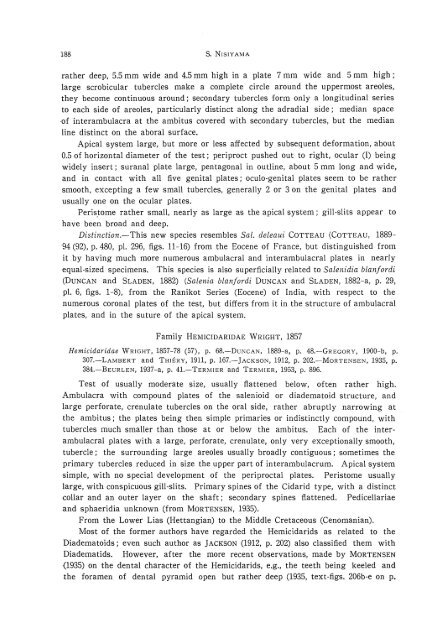the echinoid fauna from japan and adjacent regions part i
the echinoid fauna from japan and adjacent regions part i
the echinoid fauna from japan and adjacent regions part i
You also want an ePaper? Increase the reach of your titles
YUMPU automatically turns print PDFs into web optimized ePapers that Google loves.
188 S. NISIYAMA<br />
ra<strong>the</strong>r deep, 5.5 mm wide <strong>and</strong> 4.5 mm high in a plate 7 mm wide <strong>and</strong> 5 mm high;<br />
large scrobicular tubercles make a complete circle around <strong>the</strong> uppermost areoles,<br />
<strong>the</strong>y become continuous around; secondary tubercles form only a longitudinal series<br />
to each side of areoles, <strong>part</strong>icularly distinct along <strong>the</strong> adradial side; median space<br />
of interambulacra at <strong>the</strong> ambitus covered with secondary tubercles, but <strong>the</strong> median<br />
line distinct on <strong>the</strong> aboral surface.<br />
Apical system large, but more or less affected by subsequent deformation, about<br />
0.5 of horizontal diameter of <strong>the</strong> test; periproct pushed out to right, ocular (1) being<br />
widely insert; suranal plate large, pentagonal in outline, about 5 mm long <strong>and</strong> wide,<br />
<strong>and</strong> in contact with all five genital plates; oculo-genital plates seem to be ra<strong>the</strong>r<br />
smooth, excepting a few small tubercles, generally 2 or 3 on <strong>the</strong> genital plates <strong>and</strong><br />
usually one on <strong>the</strong> ocular plates.<br />
Peris.tome ra<strong>the</strong>r small, nearly as large as <strong>the</strong> apical system; gill-slits appear to<br />
have been broad <strong>and</strong> deep.<br />
Distinction.-This new species resembles Sal. deleaui COTTEAU (COTTEAU, 1889-<br />
94 (92), p. 480, pI. 296, figs. 11-16) <strong>from</strong> <strong>the</strong> Eocene of France, but distinguished <strong>from</strong><br />
it by having much more numerous ambulacral <strong>and</strong> interambulacral plates in nearly<br />
equal-sized specimens. This species is also superficially related to Salenidia blanfordi<br />
(DUNCAN <strong>and</strong> SLADEN, 1882) (Salenia blanfordi DUNCAN <strong>and</strong> SLADEN, 1882-a, p. 29,<br />
pI. 6, figs. 1-8), <strong>from</strong> <strong>the</strong> Ranikot Series (Eocene) of India, with respect to <strong>the</strong><br />
numerous coronal plates of <strong>the</strong> test, but differs <strong>from</strong> it in <strong>the</strong> structure of ambulacral<br />
plates, <strong>and</strong> in <strong>the</strong> suture of <strong>the</strong> apical system.<br />
Family HEMICIDARIDAE WRIGHT, 1857<br />
Hemicidaridae WRIGHT, 1857-78 (57), p. 68.-DuNCAN, 1889-a, p. 48.-GREGORY, 1900-b, p.<br />
307.-LAlvlBERT <strong>and</strong> THIERY, 1911, p. 167.-JAcKsoN, 1912, p. 202.-MoRTENSEN, 1935, p.<br />
384.-BEURLEN, 1937-a, p. 41.-TERMIER <strong>and</strong> TERMIER, 1953, p. 896.<br />
Test of usually moderate size, usually flattened below, often ra<strong>the</strong>r high.<br />
Ambulacra with compound plates of <strong>the</strong> salenioid or diadematoid structure, <strong>and</strong><br />
large perforate, crenulate tubercles on <strong>the</strong> oral side, ra<strong>the</strong>r abruptly narrowing at<br />
<strong>the</strong> ambitus; <strong>the</strong> plates being <strong>the</strong>n simple primaries or indistinctly compound, with<br />
tubercles much smaller than those at or below <strong>the</strong> ambitus. Each of <strong>the</strong> interambulacral<br />
plates with a large, perforate, crenulate, only very exceptionally smooth,<br />
tubercle; <strong>the</strong> surrounding large areoles usually broadly contiguous; sometimes <strong>the</strong><br />
primary tubercles reduced in size <strong>the</strong> upper <strong>part</strong> of interambulacrum. Apical system<br />
simple, with no special development of <strong>the</strong> periproctal plates. Peristome usually<br />
large, with conspicuous gill-slits. Primary spines of <strong>the</strong> Cidarid type, with a distinct<br />
collar <strong>and</strong> an outer layer on <strong>the</strong> shaft; secondary spines flattened. Pedicellariae<br />
<strong>and</strong> sphaeridia unknown (<strong>from</strong> MORTENSEN, 1935).<br />
From <strong>the</strong> Lower Lias (Hettangian) to <strong>the</strong> Middle Cretaceous (Cenomanian).<br />
Most of <strong>the</strong> former authors have regarded <strong>the</strong> Hemicidarids as related to <strong>the</strong><br />
Diadematoids; even such author as JACKSON (1912, p. 202) also classified <strong>the</strong>m with<br />
Diadematids.<br />
(1935) on <strong>the</strong><br />
<strong>the</strong> foramen<br />
However, after <strong>the</strong> more recent observations, made by MORTENSEN<br />
dental character of <strong>the</strong> Hemicidarids, e.g., <strong>the</strong> teeth being keeled <strong>and</strong><br />
of dental pyramid open but ra<strong>the</strong>r deep (1935, text-figs. 206b-e on p.












